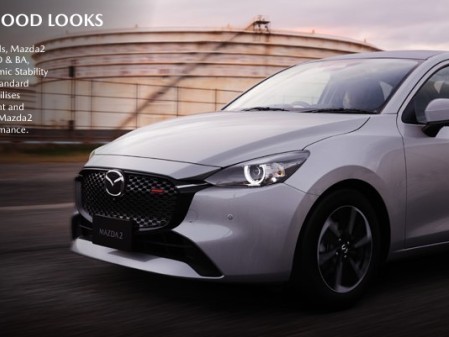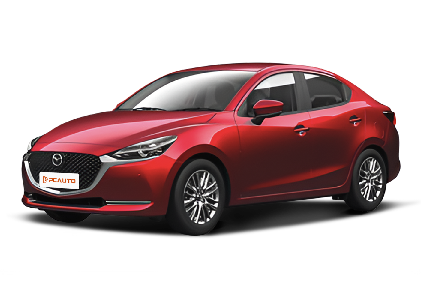Q
What engine is a Mazda 2 equipped with ?
The Mazda 2 is equipped with a 1.5L naturally aspirated engine with an NA intake system, an inline (L) cylinder configuration, and four cylinders. This engine delivers a maximum horsepower of 114PS, with peak power output at 6000rpm and maximum torque of 149N·m at 4000rpm.
The engine provides stable power output to meet daily driving demands. It incorporates multiple advanced technologies, such as an automatic start-stop system that shuts off the engine during brief stops and restarts when moving off, helping to save fuel and reduce emissions. The hill-start assist function prevents rollback when starting on inclines, enhancing driving safety. Additionally, the engine is paired with an AT transmission for smooth gear shifts and improved driving comfort.
Special Disclaimer: This content is published by users and does not represent the views or position of PCauto.
Related Q&A
Q
Does Mazda 2 have folding mirrors?
Yes, the Mazda2 Comes Standard with Power Folding Side Mirrors. This convenient feature allows you to easily fold the mirrors inward, which is especially useful for parking in tight spaces or navigating narrow roads, helping to protect the mirrors from potential damage.
In addition, the Mazda2 offers other mirror-related functionalities. Its side mirrors provide excellent visibility with no blind spots, and they have a small frontal area that reduces wind resistance. Furthermore, it is equipped with a mirror heating function, controlled by a switch located near the climate control panel, shared with the rear defroster. When activated, both the rear windshield and the exterior side mirrors will be heated for 15 minutes to eliminate fogging in rainy or snowy weather.
Q
Is the Mazda 2 the same as the Toyota Yaris?
The Mazda 2 is different from the Toyota Yaris. In terms of body structure, the Mazda 2 offers 4-door 5-seat sedan models, while the Yaris is typically a 5-door 5-seat hatchback. Their dimensions also vary, which affects interior space. For example, different models have different lengths, widths, heights, and wheelbases.
In terms of performance, although both may be equipped with petrol engines, their power output, torque, and fuel consumption differ. The Mazda 2 has its own unique engine tuning and performance characteristics.
Regarding features, each vehicle comes with its own set of standard and optional equipment, including safety features, infotainment systems, and comfort amenities. For instance, the headlight types, seat adjustment methods, and air-conditioning zoning may vary between the two models. Therefore, the Mazda 2 and Toyota Yaris are distinct vehicles with their own characteristics.
Q
How often should the Mazda2 be serviced?
The maintenance frequency for the Mazda2 depends on various factors. Generally speaking, under normal driving conditions, it is recommended to follow these guidelines. The first service is typically advised at around 5,000 kilometers or about 6 months of use, which helps to inspect vehicle components during the initial break-in period. After the first service, subsequent general maintenance intervals are usually every 10,000 kilometers or 12 months.
However, if you drive under harsh conditions, such as in dusty environments, frequent stop-and-go traffic, or short trips, you may need to service your vehicle more frequently. In this case, changing the oil and oil filter every 5,000 kilometers or every 3-6 months is a good practice. In dusty areas, the air filter may need to be cleaned every 10,000 kilometers or 6 months, while it should be replaced every 20,000 kilometers or 24 months under normal conditions. Brake fluid should be regularly checked and replaced every 2-4 years, depending on usage.
Regular maintenance not only ensures that your Mazda2 runs smoothly but also extends its lifespan and enhances safety.
Q
Is Mazda 2 economical?
The Mazda2 is considered a relatively economical model. It is equipped with a 1.5L naturally aspirated engine, with an official combined fuel consumption of 5.3L/100km. This level of fuel efficiency is commendable among its peers, helping owners save on fuel costs. Additionally, the vehicle comes with a warranty of 5 years or 100,000 kilometers, providing a longer coverage period that can help mitigate potential high repair expenses in the future.
In terms of pricing, taking the 2023 Mazda 2 Sedan 1.5L as an example, it is priced between RM97,000 and RM107,000 (depending on the variant), making it competitively priced in its segment. The interior features are quite practical, with standard equipment such as automatic parking assist and engine start-stop technology, which not only facilitates driving but also aids in fuel saving. While it may not be the most powerful in terms of performance, considering fuel efficiency, warranty, price, and other factors, the Mazda2 demonstrates solid value in terms of economy, making it an ideal choice for consumers seeking a budget-friendly and practical vehicle.
Q
Is the Mazda 2 a family car?
The Mazda2 can be seen as a family vehicle. It features a 5-seat layout, making it suitable for the daily travel needs of small families. While the interior space isn't particularly large, it provides sufficient room for passengers, and the rear seats come with a 60:40 split-folding function, allowing for increased cargo space when needed for items like strollers or groceries.
In terms of safety, it comes standard with features such as ABS, electronic stability control, at least two airbags, and ISOFIX child seat anchors, which are all crucial for a family car. Fuel efficiency is also a significant highlight, with an official combined consumption of 5.3 liters per 100 kilometers, helping to lower everyday travel costs. Additionally, it boasts convenient features like keyless entry, automatic climate control, and a touchscreen infotainment system, enhancing overall comfort for family journeys.
Q
Does Mazda 2 have reversing camera?
Yes, the Mazda 2 is equipped with a reversing camera. All listed Mazda 2 models feature a "parking image system: front and rear cameras," indicating they come with both front and rear cameras, including a reversing camera. This feature is highly practical as it provides drivers with a clear view of the area behind the vehicle when reversing. It enhances safety by minimizing blind spots and making it easier to avoid collisions with obstacles, pedestrians, or other vehicles. Additionally, the inclusion of this feature increases parking convenience in various scenarios, whether in tight parking spaces or on busy streets.
Q
Is Mazda 2 a sport car?
The Mazda 2 is not a traditional sports car in the strict sense, but it does possess some sporty characteristics. Its engine delivers relatively smooth and linear power output. For instance, the equipped 1.5L naturally aspirated engine produces a maximum horsepower of 114PS and provides responsive power delivery as the revs climb. Regarding the suspension system, the tuning of the front MacPherson strut and rear torsion beam independent suspension ensures daily driving comfort while maintaining adequate cornering support to reduce body roll. Externally, it inherits the family's "Kodo" design style, featuring a shield-shaped front grille integrated with sleek headlights, flowing side profiles, and a compact yet refined rear end that conveys athleticism. However, sports cars typically prioritize high-performance engines, lightweight construction, and robust power output. The Mazda 2 primarily targets the mainstream consumer market, emphasizing overall practicality, fuel efficiency, and comfort rather than being designed as a dedicated sports car focused on extreme speed or track performance.
Q
Does the Mazda 2 have a touch screen?
The latest Malaysian version of the Mazda2 (2024) is not equipped with a traditional touchscreen. Instead, it features a 7-inch non-touch central display, which operates through the Mazda Connect infotainment system using a rotary knob and buttons on the center console. This design aims to reduce driver distraction and enhance safety.
Although it doesn't support touch input, the system is compatible with Apple CarPlay and Android Auto (via wired connection), allowing users to easily access navigation, music, and other smartphone features. Mazda adheres to a "driver-oriented" design philosophy, ensuring that even the entry-level Mazda2 does not compromise on the logic of operation. While users who heavily rely on touch controls may need a brief adjustment period, the precision and smoothness of the rotary control prove to be very practical in Malaysia's driving conditions.
Q
Does the Mazda2 perform well on the highway?
The Mazda 2 performs well on the highway. It is equipped with a 1.5L naturally aspirated engine, paired with a 6-speed automatic transmission, delivering 114 horsepower and 149 Nm of torque, which meets normal acceleration and overtaking demands on the highway. In terms of handling, Mazda's precise steering system stands out as a key advantage. At high speeds, drivers can accurately control the vehicle's direction. Its well-tuned suspension system effectively absorbs road imperfections and minimizes body roll, ensuring a stable driving experience. For safety, standard features include ABS anti-lock braking and vehicle stability control, providing added security during highway driving. The cabin also offers amenities like a HUD head-up display and a multifunction steering wheel, enhancing driving convenience. However, Mazda vehicles typically have room for improvement in noise insulation at high speeds since the Mazda 2's wind and road noise may be somewhat noticeable on the highway.
Q
What is the driving range of a Mazda2 on a full tank?
The fuel tank capacity of the Mazda 2 is 44L, and the official combined fuel consumption is 5.3L per 100km. Calculated based on these data, it can travel approximately 830 kilometers when the fuel tank is full (44÷5.3×100 ≈ 830). However, the actual driving range will be affected by various factors. For example, driving style matters. Aggressive acceleration and sudden braking will increase fuel consumption and reduce the driving range. Driving smoothly and shifting gears reasonably result in relatively lower fuel consumption, and the driving range may be closer to the theoretical value. Road conditions also have a significant impact. On smooth highways, the vehicle can maintain an economical speed, and the driving range will increase. In congested urban roads, with frequent starts and stops, fuel consumption increases, and the driving range will be shortened. In addition, vehicle load, tire pressure, etc. will also affect fuel consumption.
Latest Q&A
Q
Does the BMW X3 2020 have CarPlay?
The 2020 BMW X3 does come with Apple CarPlay functionality. Back then, this feature was either a standard offering or an optional extra, depending on the specific trim level and equipment package of the vehicle. Drivers can seamlessly connect their iPhones through the iDrive system on the central display, accessing common apps like navigation, music, and calls. The interface is intuitive and supports Siri voice control, which really boosts convenience and safety behind the wheel. It's worth noting that CarPlay initially required a wired connection via the USB port, though some later software updates might have enabled wireless connectivity. To be sure, it's best to check your specific vehicle's configuration using the VIN or consulting local dealers. As for the infotainment system, both BMW's iDrive 6.0 and 7.0 versions offer solid compatibility. If you run into connection issues, try updating your phone's OS or the car's software. Android users can also connect their devices using Android Auto, which offers similar functionality, though there are some differences in app ecosystem support to keep in mind. For those looking to enhance their experience even further, exploring BMW's optional extras like enhanced Bluetooth and wireless charging is a good idea. These features complement CarPlay nicely – wireless charging, for example, eliminates the battery anxiety that can come with prolonged wired connections.
Q
Does the BMW X3 2020 have remote start?
The 2020 BMW X3 offers remote start functionality on select trims, though it requires the vehicle to be equipped with ConnectedDrive services along with the appropriate key or mobile app, like the BMW Connected App. This feature lets owners fire up the engine and adjust the cabin temperature via their smartphone beforehand—super handy for pre-warming or cooling the interior during extreme hot or cold weather. If your X3 didn’t come with it factory-installed, you can usually have the relevant module added later through an authorized BMW dealer, but make sure to check compatibility and warranty terms first. Remote start tech has become pretty common these days; beyond BMW, plenty of other brands offer similar features, though the specifics can vary—some might require a subscription or depend on certain network coverage. It’s a good idea to check your owner’s manual or hit up your dealer to confirm your exact setup, and also be aware of local laws regarding engine idling time to stay compliant. These kinds of tech features definitely boost convenience, but it’s still important to get familiar with how they work and any important dos and don’ts.
Q
Is there a recall on the BMW 3 Series 2020?
Regarding whether there's a recall for the 2020 BMW 3 Series, according to official records, this model has been subject to recalls worldwide due to potential issues with certain components, such as the fuel pump module or software system updates. However, the specific recall scope needs to be confirmed by checking the Vehicle Identification Number (VIN) on BMW's official website or at an authorized service center. It's advisable for owners to regularly pay attention to official notifications or directly contact local dealerships for the latest information to ensure the vehicle's safety performance meets standards. Additionally, regardless of whether a recall is involved, regular maintenance and inspections are crucial for maintaining the vehicle's condition, especially for electronic systems and key components. BMW's intelligent diagnostic tools can detect potential issues in advance. If any abnormalities are noticed, such as warning lights on the dashboard or unusual noises while driving, they should be addressed promptly to prevent minor problems from developing into safety hazards. For used car buyers, it's recommended to verify maintenance and recall records through official channels before purchasing to ensure transparency in the vehicle's history.
Q
Does the 2020 BMW X3 have a touch screen?
The 2020 BMW X3 does come with a touchscreen. It's equipped with BMW's latest iDrive 7.0 system, featuring a 10.25-inch center display that supports touch operation while still retaining the traditional rotary knob control, making it easy for drivers to operate quickly on the move. Beyond touch functionality, this screen also supports voice control and gesture commands, offering a more intelligent interactive experience. In the local market, the car's configuration is largely consistent with global versions. Owners can directly access navigation, entertainment, vehicle settings, and other functions through the screen, and the system also supports wireless Apple CarPlay, further enhancing convenience. It's worth noting that the iDrive 7.0 system has an intuitive interface design and fast response times, so even users new to BMW models can get the hang of it quickly. If you have high demands for in-car technology, the 2020 X3's system should meet your daily needs, and its hardware and software performance are also among the leading in its class.
Q
What generation is the 2020 BMW X3?
The 2020 BMW X3 belongs to the third generation (chassis code G01), which first launched in 2017 and got a mid-cycle refresh in 2020, mainly updating the exterior design and tech features. The third-gen X3 rides on BMW's CLAR modular platform, which not only cuts down on weight but also improves handling and fuel efficiency, while offering more spacious interior room. Under the hood, the 2020 X3 offers multiple options, including a 2.0L four-cylinder turbo engine and a 3.0L inline-six turbo, with some models getting the xDrive all-wheel-drive system to suit different driving needs. This generation also brings more smart driver assistance features, like adaptive cruise control and lane-keeping assist, further boosting driving safety. For consumers who love luxury SUVs, the 2020 X3 is a solid pick—it combines BMW's traditional driving fun with practicality, and its tech features keep up with the times. If you're interested in this car, head to a nearby dealership for a test drive and experience its performance firsthand.
View MoreRelated News

At the same price of RM 108,670, Mazda 2 Sedan vs Hatchback, which one is more suitable for you?
WilliamSep 3, 2024

Rumor: Toyota and Mazda collaborate to develop the next-generation MX-5 and GR86
AshleySep 30, 2025

MAZDA EZ-60 will be launched in China, and will be available in other global markets in 2026
RobertSep 30, 2025

CX-80 too large? Too expensive? Mazda also offers you the CX-60
WilliamSep 4, 2025

Mazda Malaysia Launches its Largest SUV, the CX-80, with a Price of RM331,610
Kevin WongSep 4, 2025
View More
















Pros
Cons